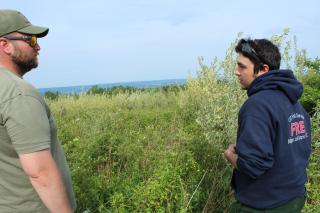Leveling the field for native regrowth

NEW YORK—If you happen to venture past Teeter Pasture and Potomac South Grassland in the Finger Lakes National Forest, you may have seen a field of pollinating vegetation, thick and green, heavily dusted with tiny white flowers. As you stop to admire the view, you may have also quickly spotted the piece of construction equipment slowly plowing through those beautiful wild shrubs. As the skid steer operator grinds its way through the landscape, large chunks of woody debris are ripped from the ground and sent outward. Why would anyone do this?
That field of flowers might be pretty to some, but for neighbors and land managers, it’s the site of an invasion. That pollinating vegetation is a sea of non-native invasive honeysuckle, multi flora rose and autumn olive. Every year there is more of it, and what’s left of native vegetation is being smothered out. The sight of a skid steer mounted mastication machine fighting back is a welcome one.
Non-native invasive species have come to dominate fields like Teeter Pasture and Potomac South Grassland. They rapidly outcompete native forb species as well as desirable cool season grasses, making it difficult for native species to continue to grow. Before long, they may also come to dominate the attention of pollinators as well, increasing their own numbers and further threatening the spread of native species.
As acres turn from native forbs and desirable cool season grasses to a mix of non-native species, birds see their home range transition from grasslands to early successional forest. To some this may seem like a natural transition, and it is, but there are specific species like Henslow’s sparrow and grasshopper sparrow that need high-quality grassland habitat to complete nesting and foraging. Additionally, the berries on non-native plants that birds are filling up on lack the proper nutrition they need to sustain their flights, leading to more time stopped to forage for quality food mid-migration. Furthermore, native pollinators can be outcompeted by non-native pollinators who preferentially pollinate non-native plants. By completing projects like this and resetting the vegetation to native desirable species both birds and bees benefit.
Not only do honeysuckle and other non-natives spread rapidly, they are also hard for land managers to combat once they take off. Honeysuckle is woody, grows in dense and fast, and does not allow sunlight to the ground, therefore removing all ground vegetation. Trying to clear a few acres by hand would be futile. “We couldn’t possibly keep up. If we went into that field and tried to hand-pull just honeysuckle there’d be a new field of it long before we finished,” says wildlife biologist Greg Flood.
Flood says they won’t eradicate the intruding invasives completely, but they can slow the spread and they can help native species better compete. With funding from the Great Lakes Restoration Initiative Action Plan to improve pollinator habitat and promote native species, the forest was able to rent equipment and enlist the help of Job Corps students to do the heavy restoration work.
Two Forest Service Job Corps students learning to operate heavy machinery spent a month in the Finger Lakes clearing approximately 75 acres. They gained experience and practice hours on their machines. They also saw how their work contributes to the Forest Service mission.
“I like to host Job Corps students on the forest whenever we can,” says Flood. “When the students are here, it’s easy for them to see the positive impact of natural resource management and the ripple effect across the landscape. Not only do they do great work for us, they are earning Public Land Corps hours, getting firsthand on-the-job training for the program in which they are enrolled and gaining valuable insights into public land management. It is truly a win-win situation!”

